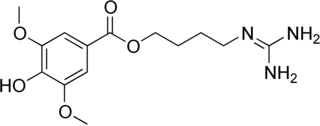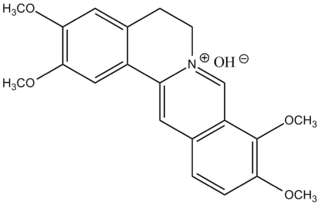
Taurine, or 2-aminoethanesulfonic acid, is a non-proteinogenic amino sulfonic acid that is widely-distributed in animal tissues. It is a major constituent of bile and can be found in the large intestine, and accounts for up to 0.1% of total human body weight. It is named after Latin taurus meaning bull or ox, as it was first isolated from ox bile in 1827 by German scientists Friedrich Tiedemann and Leopold Gmelin. It was discovered in human bile in 1846 by Edmund Ronalds.

The liver X receptor (LXR) is a member of the nuclear receptor family of transcription factors and is closely related to nuclear receptors such as the PPARs, FXR and RXR. Liver X receptors (LXRs) are important regulators of cholesterol, fatty acid, and glucose homeostasis. LXRs were earlier classified as orphan nuclear receptors, however, upon discovery of endogenous oxysterols as ligands they were subsequently deorphanized.

Ursolic acid, is a pentacyclic triterpenoid identified in the epicuticular waxes of apples as early as 1920 and widely found in the peels of fruits, as well as in herbs and spices like rosemary and thyme.

The sigma-2 receptor (σ2R) is a sigma receptor subtype that has attracted attention due to its involvement in diseases such as cancer and neurological diseases. It is currently under investigation for its potential diagnostic and therapeutic uses.

The 5HT6 receptor is a subtype of 5HT receptor that binds the endogenous neurotransmitter serotonin (5-hydroxytryptamine, 5HT). It is a G protein-coupled receptor (GPCR) that is coupled to Gs and mediates excitatory neurotransmission. HTR6 denotes the human gene encoding for the receptor.

Hydroxycarboxylic acid receptor 2 (HCA2), also known as niacin receptor 1 (NIACR1) and GPR109A, is a protein which in humans is encoded by the HCAR2 gene. HCA2, like the other hydroxycarboxylic acid receptors HCA1 and HCA3, is a Gi/o-coupled G protein-coupled receptor (GPCR). The primary endogenous agonists of HCA2 are D-β-hydroxybutyric acid and butyric acid (and their conjugate bases, β-hydroxybutyrate and butyrate). HCA2 is also a high-affinity biomolecular target for niacin (aka nicotinic acid).

Metabotropic glutamate receptor 5 is an excitatory Gq-coupled G protein-coupled receptor predominantly expressed on the postsynaptic sites of neurons. In humans, it is encoded by the GRM5 gene.

Serine/threonine-protein kinase PAK 5 is an enzyme that in humans is encoded by the PAK5 gene.

Fibroblast growth factor 21 is a liver-secreted peptide hormone that in humans is encoded by the FGF21 gene. Together with FGF19 and FGF23, this protein is a member of the endocrine subgroup within the fibroblast growth factor (FGF) family. FGF21 is a potent, extracellularly acting metabolic regulator, whose action was discovered through in vitro phenotypic screeninig and diet manipulation studies in rodents., unlike canonical growth-stimulating FGFs known to stimulate mitosis, differentiation and angiogenesis in their target tissues, FGF21 exerts its action by activating FGF21 receptors located in the cell membrane of target cells. Each FGF21 receptor is composed of a transmembrane FGF receptor protein, and its complexing co-receptor β-Klotho. Loss of β-Klotho abolishes all effects of FGF21 in vitro and in vivo. In addition to its action as a hormone, FGF21 may be able to act in an autocrine fashion, or possibly also in a paracrine manner in the pancreas.

Blonanserin, sold under the brand name Lonasen, is a relatively new atypical antipsychotic commercialized by Dainippon Sumitomo Pharma in Japan and Korea for the treatment of schizophrenia. Relative to many other antipsychotics, blonanserin has an improved tolerability profile, lacking side effects such as extrapyramidal symptoms, excessive sedation, or hypotension. As with many second-generation (atypical) antipsychotics it is significantly more efficacious in the treatment of the negative symptoms of schizophrenia compared to first-generation (typical) antipsychotics such as haloperidol.

Leonurine is a pseudoalkaloid that has been isolated from Leonotis leonurus, Leonotis nepetifolia, Leonurus japonicus, Leonurus cardiaca (motherwort), Leonurus sibiricus, as well as other plants of family Lamiaceae. Leonurine is easily extracted into water.

Palmatine is a protoberberine alkaloid found in several plants including Phellodendron amurense, Coptis Chinensis and Corydalis yanhusuo, Tinospora cordifolia, Tinospora sagittata, Phellodendron amurense, Stephania yunnanensis.

Chrysophanol, also known as chrysophanic acid, is a fungal isolate and a natural anthraquinone. It is a C-3 methyl substituted chrysazin of the trihydroxyanthraquinone family.

Tropoflavin, also known as 7,8-dihydroxyflavone, is a naturally occurring flavone found in Godmania aesculifolia, Tridax procumbens, and primula tree leaves. It has been found to act as a potent and selective small-molecule agonist of the tropomyosin receptor kinase B (TrkB), the main signaling receptor of the neurotrophin brain-derived neurotrophic factor (BDNF). Tropoflavin is both orally bioavailable and able to penetrate the blood–brain barrier. A prodrug of tropoflavin with greatly improved potency and pharmacokinetics, R13, is under development for the treatment of Alzheimer's disease.

Pseudoginsenoside F11 is a chemical natural product found in American ginseng but not in Asian ginseng, although it has similar properties to the Asian ginseng compound ginsenoside Rf. The molecule is a triterpenoid saponin member of the dammarane family and contains a four-ring rigid skeleton. Compounds in the ginsenoside family are found almost exclusively in plants of the genus Panax. A wide variety of difficult-to-characterize in vitro effects have been reported for the compounds in isolation. Pseudoginsenoside F11 and its derivatives are sometimes referred to as having an ocotillol-type skeleton structure.

ANA-12 is a selective, small-molecule non-competitive antagonist of TrkB, the main receptor of brain-derived neurotrophic factor (BDNF). The compound crosses the blood-brain-barrier and exerts central TrkB blockade, producing effects as early as 30 minutes and as long as 6 hours following intraperitoneal injection in mice. It blocks the neurotrophic actions of BDNF without compromising neuron survival.

Geniposide, the glycoside form of genipin, is a bioactive iridoid glycoside that is found in a wide variety of medicinal herbs, such as Gardenia jasminoides (fruits) . Geniposide shows several pharmacological effects including neuroprotective, antidiabetic, hepatoprotective, anti-inflammatory, analgesic, antidepressant-like, cardioprotective, antioxidant, immune-regulatory, antithrombotic and antitumoral activity. These pharmacology benefits arise through the modulating action of geniposide on several proteins and genes that are associated with inflammatory and oxidative stress processes.
Purple sweet potato color (PSPC) is a natural anthocyanin food coloring obtained from the sweet potato. Some cultivars, like the Ayamurasaki, released in Japan in 1995, are specially developed to have a higher anthocyanin content.

β-LGND2, also known as ERβ-selective ligand 2 or as GTx-878, is a synthetic nonsteroidal estrogen and selective ERβ agonist which was under development by GTx for the treatment of benign prostatic hyperplasia, prostatitis, and rheumatoid arthritis but was never marketed. It shows approximately 25-fold selectivity for activation of the ERβ over the ERα (EC50 = 2 nM and 52 nM, respectively). β-LGND2 is an isoquinolinone derivative.

Tomatidine is an anabolic chemical compound that prevents muscle wasting. It is naturally found in leaves of tomatoes and green tomatoes. Chemically, it is the aglycone of tomatine. It has been shown to have multiple health benefits. Tomatidine is an inhibitor of skeletal muscle atrophy, and a potential therapeutic agent for aging-associated sarcopenia, reducing weakness and atrophy in aged skeletal muscle by interaction with the ATF4.



















